Best Electrician Staff Scheduling Software 2025: Key Features & Objections Addressed
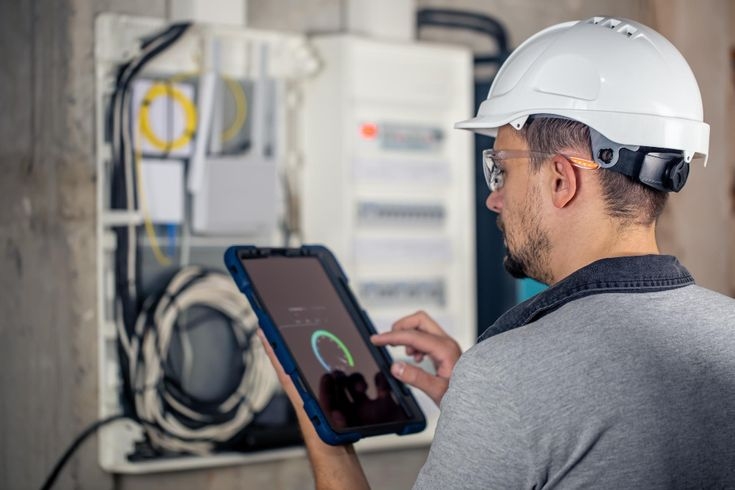
Electricians power our homes, offices, and industries—but behind every job is a scheduling challenge: who’s on call, where’s the crew, and which urgent task comes first? Electrician staff scheduling isn’t just filling calendar slots—it’s about coordinating skilled pros across sites, handling emergencies, balancing job types, and staying compliant with safety rules.
Paper calendars and spreadsheets work for small shops, but as work grows, they break down. Electrical contractors juggle multiple jobs daily, and one missed appointment can mean wasted time, unhappy customers, and delayed projects. Without reliable software, dispatchers can’t easily track availability, location, or skills—causing longer waits, idle crews, and lost profits.
If you’re looking for scheduling software for electricians or an electrical contractor scheduling app, this guide is for you. By the end, you’ll see why the right software matters, what features to prioritize, how top tools compare, and how Shifts by Everhour—though not electrician-specific—can still be a modern, reliable choice for scheduling field teams.
⚡ The High Stakes of Electrician Staff Scheduling
Running an electrical business is a constant balancing act. Between urgent outages, scheduled maintenance, and customer expectations, one scheduling slip can mean lost time, lost revenue, and unhappy clients.
Growing workloads and multiple job types
Rewiring a historic home in the morning. Installing EV chargers after lunch. Responding to a hospital outage at 5 PM. Without smart scheduling:
- 🕒 Travel times balloon
- 📅 Jobs overlap
- 🛠 Crews spend hours driving instead of working
Dispatch and communication breakdowns
Real-time dispatching = right electrician, right job, right now.
📍 See availability, skills, and location at a glance
🔄 Instantly reroute crews for emergencies
Without it? Expect late arrivals, missed calls, and unhappy customers.
Customer expectations and emergency calls
⚡ Emergencies can’t wait. A good system rearranges jobs without pushing other clients aside. Reliability builds trust — and trust brings repeat business.
Safety, compliance, and certifications
Some jobs demand specific licenses or high-voltage certifications. A scheduling tool with credential tracking ensures the right tech is sent — keeping you compliant and your team safe.
Costly mistakes and paperwork
📄 Paper schedules = double bookings, missed inspections, and angry customers
💻 Digital scheduling keeps details in one place — no more “copy & paste” disasters
💬 Real users say:
“We run a small shop with 6 techs on Google Calendar + Slack. Twice last week crews went to the wrong address. We switched to a scheduling app that syncs with our CRM — now mistakes are almost zero.”
💡 What Is Electrician Staff Scheduling Software? (And What It Isn’t)
Electrician scheduling software is a digital tool for planning and managing your crews’ work. It blends:
- 📅 Scheduling
- 🚚 Dispatch
- 💬 Communication
- (sometimes) 💵 Invoicing & customer management
As BuildOps explains, it gives you full visibility into:
- Which jobs are scheduled
- Who’s assigned
- When and where jobs take place
Dispatchers can match jobs to technicians based on:
- Job type
- Customer availability
- Skills required
- Travel distance
Techs then get real-time updates through mobile apps.
Not all scheduling tools are the same
-
Electrician scheduling:
Creates job schedules, assigns technicians, and sends notifications.
Perfect if you already have separate systems for quotes, CRM, or invoicing. -
Electrical contractor scheduling software:
Adds customer management, invoicing, estimates, inventory, and reporting. -
Field service management (FSM) platforms:
All-in-one systems like ServiceTitan or Jobber that combine scheduling with CRM, marketing, inventory, time tracking, and analytics.
💭 Choosing the right one
- Small shops: simple scheduling tools
- Large contractors: integrated FSM platforms
🔨 Must‑Have Features of Electrician Staff Scheduling Software
Here are the core features your scheduling solution should offer:
🚦 1. Real-time dispatch management
Real-time dispatch tools assign the right electrician as soon as a job comes in and let dispatchers see schedules and technician locations. Key capabilities include:
- Live calendar with drag-and-drop scheduling – quickly reassign jobs during emergencies or delays
- Skill and license filtering – match electricians based on certifications and experience
- Automatic notifications – notify techs via SMS or app when schedules change
- GPS or map integration – locate nearby techs and plan routes
📇 2. Customer and job management
A good scheduling tool centralizes customer data, service history, job notes, and contact details. This helps dispatch smarter and prevents techs from arriving unprepared. Look for:
- CRM integration or built-in customer profiles
- Service history and notes accessible on mobile apps
- Easy rescheduling and repeat visits from the job record
📱 3. Mobile access for field techs
Techs should get instant access to schedules, job details, and updates without calling the office. Features include:
- Clock in/out, upload photos, complete checklists
- Capture digital signatures on-site
- View client info, tasks, checklists, photos, and signatures on smartphones
⏱️ 4. Time tracking and reporting
Track job durations and labor costs with:
- Automatic time logs through the mobile app
- Dead time tracking to see time spent between jobs
- Customizable reports on profitability, productivity, and response times
🔔 5. Automated notifications and reminders
Send timely reminders to customers and techs to reduce errors and improve satisfaction:
- Customer confirmations and reminders via email/SMS
- Technician notifications for assignments or changes
- Maintenance contract reminders for recurring work
🔄 6. Recurring job and service agreement management
Manage ongoing maintenance smoothly:
- Schedule recurring jobs like routine inspections
- Send reminders for service agreement renewals
🔗 7. Integration and extensibility
Integrate with key business tools:
- Accounting software (QuickBooks, Xero) for invoices and payroll
- Estimation and quoting tools to convert quotes into scheduled jobs
- Inventory systems to ensure materials availability
📊 8. Analytics and reporting
Use data to improve scheduling and staffing decisions:
- Identify overbooked or underutilized technicians
- Adjust time estimates for specific job types
- Make informed decisions on hiring and pricing
💪 7 Benefits of Switching to Electrician Staff Scheduling Software
- 🔄 Centralizes customer information
All client details and job histories live in one place, enabling smarter scheduling and reducing repeated data entry. - ⚡ Speeds up invoicing and payments
Linking schedules to invoicing tools reduces billing delays and improves cash flow. - 🚨 Prioritizes emergency calls faster
Real-time dispatching helps you handle urgent repairs quickly by showing which techs are available and qualified. - 📅 Keeps crews fully booked without overloading
Balanced scheduling ensures techs stay productive without burnout. - ❌ Reduces costly scheduling mistakes
Automated scheduling eliminates double bookings and missed appointments. - 📈 Improves shift bidding accuracy
Historical job data informs better estimates and quotes. - 🔧 Helps plan recurring maintenance work
Software automatically schedules contract visits and inspections, keeping revenue steady.
By centralizing data, automating tasks, and providing real-time insights, scheduling software frees up your office staff and field crews to focus on delivering quality electrical work.
🤔 Comparing Top Electrician Staff Scheduling Tools: A Quick Overview
To understand the landscape, we analyzed the most frequently mentioned platforms across BuildOps, Podium, and Apploye. Here’s a side‑by‑side comparison of top options:
| Platform | Best For | Key Strengths | Limitations |
| Shifts by Everhour | Small to mid-sized contractors needing simple scheduling | Quick scheduling, mobile app, time tracking, built-in chat, free plan available | Limited CRM/quoting features; no full FSM capabilities |
| BuildOps | Commercial contractors | Real-time dispatch, AI search, customer hierarchies, invoicing, reporting | Custom pricing; complex for small teams |
| FieldEdge | Residential businesses | Drag-and-drop scheduling, history tracking, mobile app, invoicing | Limited for complex commercial jobs |
| Service Fusion | Small–mid contractors | Scheduling, invoicing, payments, job management, mobile app | Lacks advanced dispatch for large teams |
| ServiceTitan | Large service firms | Full FSM: scheduling, dispatch, CRM, invoicing, marketing | Expensive and complex for small teams |
| FieldVibe | Small field service | Mobile-first scheduling, client management, text reminders | Basic; lacks advanced coordination/reporting |
| ServiceM8 | Owner-ops & small crews | Mobile-first, scheduling, quotes, invoices, payments | Not suited for large/complex projects |
| FieldPulse | Small–mid residential/light commercial | Scheduling, estimates, job management, CRM | No property hierarchy or large-crew tools |
| Tradify | Solo electricians/small shops | Calendar scheduling, quotes, invoicing, payments | Limited dispatch & large-team support |
| Apploye/FieldServicely | GPS-based dispatch | Project management, GPS tracking, emergency dispatch | Per-user pricing; no full CRM/marketing |
This table isn’t exhaustive, but it illustrates how different electrician staff scheduling tools target specific use cases. Some—like BuildOps and ServiceTitan—are heavy-duty solutions for enterprise contractors, while others—like FieldVibe and Tradify—serve small teams with basic needs.
🧠 What Leading Electrician Staff Scheduling Tools Do Well
BuildOps
BuildOps is designed for electrical contractors who need advanced scheduling and dispatch capabilities. Key features include:
- Real-time dispatching
- Customer management
- Fleet tracking
- Mobile access
- Time tracking
- Service agreements
- Invoicing and reporting
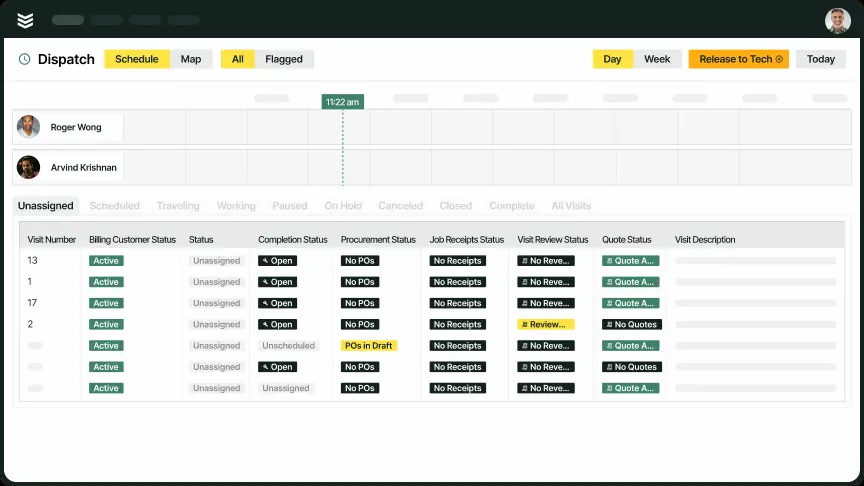
Contractors can reroute crews instantly—for example, sending a team to a commercial office with partial power loss—or adjust schedules if an EV charger installation wraps up early. The platform helps prioritize emergency calls, balance workloads, and improve bidding accuracy. It also integrates with CRM and invoicing systems for a fully connected workflow.
Podium
Podium offers more than scheduling—it’s a full client engagement and operations tool for electrical contractors. It has such useful features as:
- Client experience management
- Estimating and scheduling
- Dispatching and inventory integration
- Automated notifications
- Marketing and CRM tools
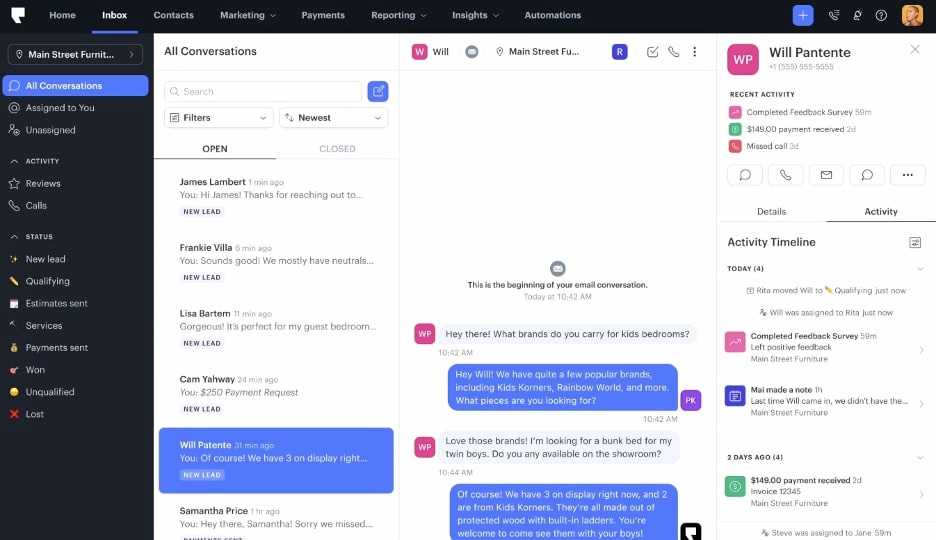
Podium also looks ahead, incorporating AI, IoT, and AR into field service management. This future-focused approach gives contractors tools to stay ahead of industry trends while building stronger customer relationships.
Apploye
Apploye delivers a well-rounded suite for managing field service operations, with strengths in:
- GPS tracking
- Scheduling
- Invoicing
- Mobile usability
- Affordability
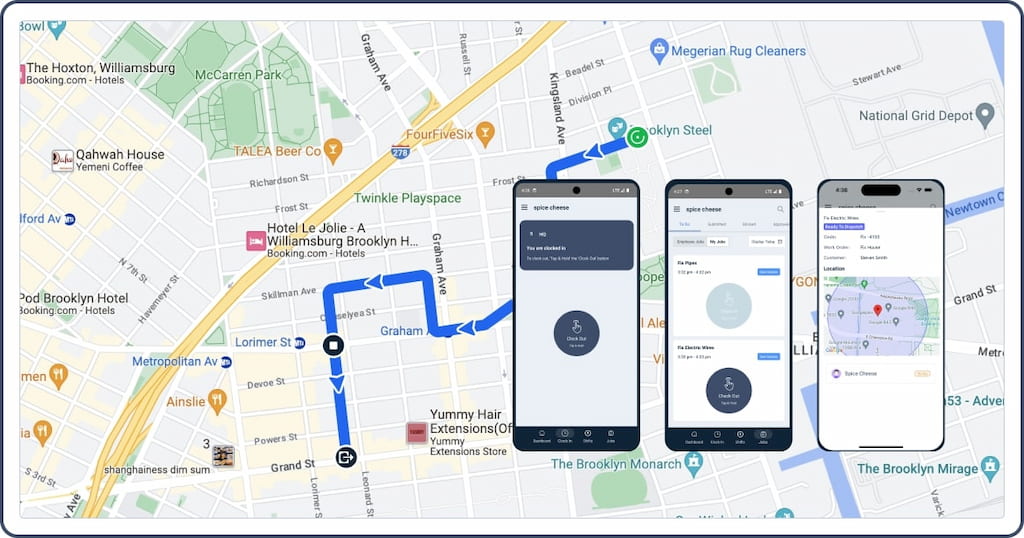
It also covers project management, financial integration, inventory control, compliance, CRM, reporting, and integrations with other platforms. Designed for transparency and precision, Apploye helps contractors streamline operations while keeping costs and performance visible in real time.
FieldVibe
FieldVibe focuses on simplicity and mobility, making it ideal for small electrical businesses. Notable features:
- Schedule jobs while on the phone with clients
- Store customer preferences
- Send automatic text reminders
- Mobile app for job details, dispatching, and organization
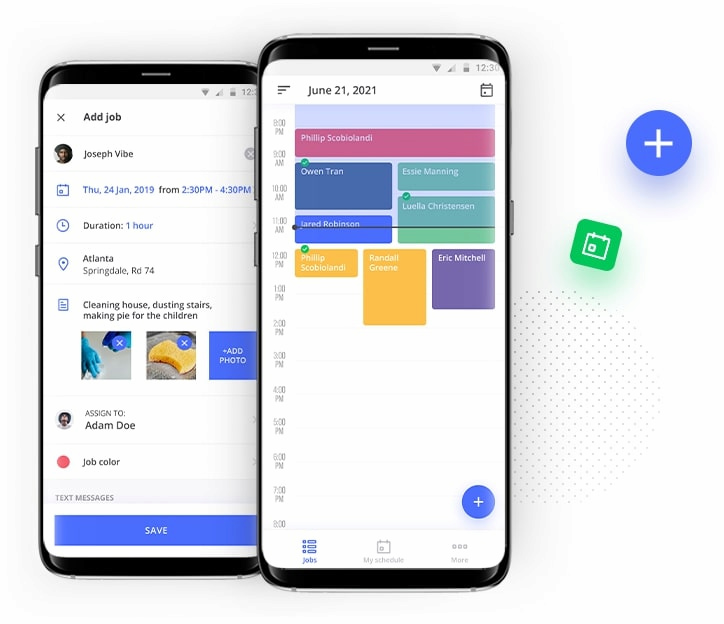
Users highlight how FieldVibe saves time and reduces scheduling headaches through real-time updates and easy communication between office and field crews.
🧠 Real-World Objections (and Responses) From Electricians
Objection 1: “We’re too small—we don’t need software.”
- 👷♂️ Small shops often think software is just for big companies.
- 📱 Even solo electricians or small crews benefit from having job details, client preferences, and reminders all in one place.
- 📈 The best tools scale with your business and help you plan growth.
- ⏰ Automated reminders prevent missed appointments and improve customer experience.
- 💡 Start simple and upgrade when ready.
Objection 2: “Spreadsheets work fine for us.”
- 📝 Spreadsheets need manual data entry and lack real-time updates or mobile access.
- 🚫 They can’t handle emergency dispatch or send automatic reminders.
- ⏳ Employee shift scheduling software saves hours and reduces missed appointments and double bookings.
Objection 3: “Our techs aren’t tech-savvy.”
- 📲 Modern apps prioritize ease of use with simple mobile interfaces.
- 📸 Techs can view job details, upload photos, and get reminders right on their phones.
- 🎯 Quick training helps reduce calls to the office and improves workflow.
Objection 4: “Software is expensive.”
- 💸 Many offer tiered plans or free versions to fit budgets.
- 📊 Consider saved time, fewer errors, happier customers, and faster billing as value.
- 🎁 Shifts by Everhour has a free plan and affordable paid options for small shops.
Objection 5: “We’ll lose the personal touch.”
- ❤️ Software doesn’t replace personal service; it frees time to build relationships.
- ⏰ Automated reminders help techs show up on time.
- 📋 Dispatchers can store client preferences so techs can personalize visits.
⚡ Case Study: From Chaos to Control for a Mid‑Sized Electrical Contractor
📝 Profile
- 🏢 Company: PowerPro Electrical Services (fictional)
- 👥 Size: 15 electricians, 3 office staff, 4 service trucks
- 📍 Service area: Residential and commercial clients across two counties
- 📅 Previous system: Google Calendar and sticky notes
🚧 Challenge
PowerPro handled installs, repairs, and maintenance. Emergency calls forced dispatchers to scramble for available techs. Miscommunication caused technicians to arrive at the wrong addresses or without needed parts. Missed appointments and overtime costs were rising.
💡 Solution
They adopted a scheduling and dispatch platform with live calendars, skill-based filtering, mobile apps, and automatic reminders. Integration with their accounting software streamlined invoicing.
📊 Results (Hypothetical)
- ✅ 30% reduction in scheduling errors
Real-time updates prevented double bookings and missed appointments. - 💸 20% decrease in overtime costs
Time tracking data identified jobs prone to overruns, allowing better schedule adjustments. - ⚡ Faster emergency response
Dispatchers rerouted crews via GPS and skill matching, reducing response time by 25%. - 🌟 Higher customer satisfaction
Automatic reminders and accurate ETAs boosted positive reviews and repeat business.
🎯 Lessons learned
- 🗂️ Centralizing schedules, customer data, and technician availability reduces miscommunication.
- ⏱️ Time tracking and reporting help adjust estimates and avoid overtime.
- 📱 Staff adoption improves when the mobile app is intuitive and training is provided.
⚡ Spotlight: Shifts by Everhour – Simple Scheduling for Electricians
Shifts by Everhour isn’t made just for electricians, but its simple design, mobile focus, and fair pricing make it a solid choice for small to mid-sized contractors who need scheduling without the bulk of a full FSM system.
Key features for electricians:
- ⏱️ Quick scheduling: Assign or update jobs in seconds and keep the team in sync.
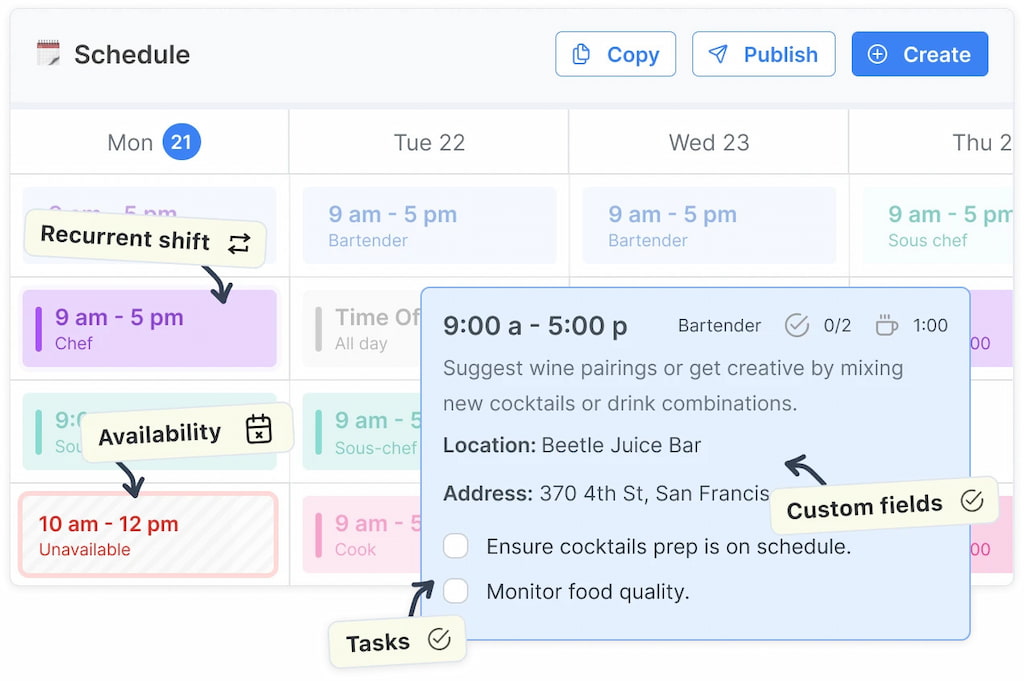
- 📅 Availability tools: Staff set their availability, request time off, and pick up open shifts.
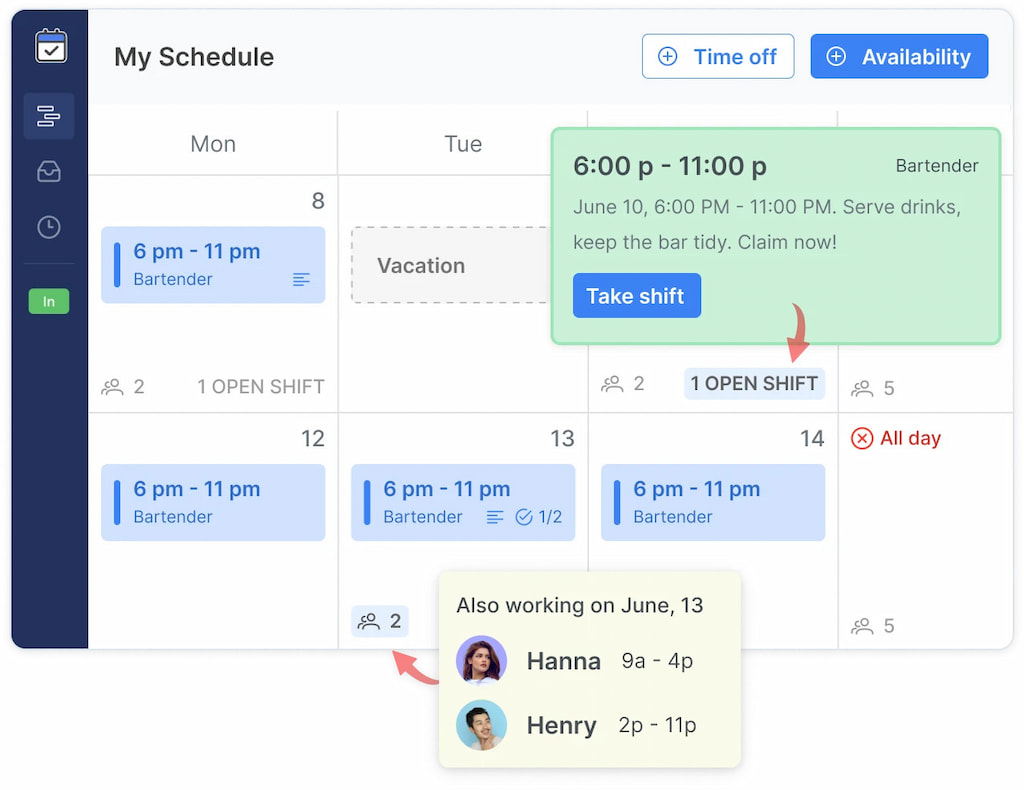
- 📱 Mobile access: Manage schedules and send updates on the go with push notifications.
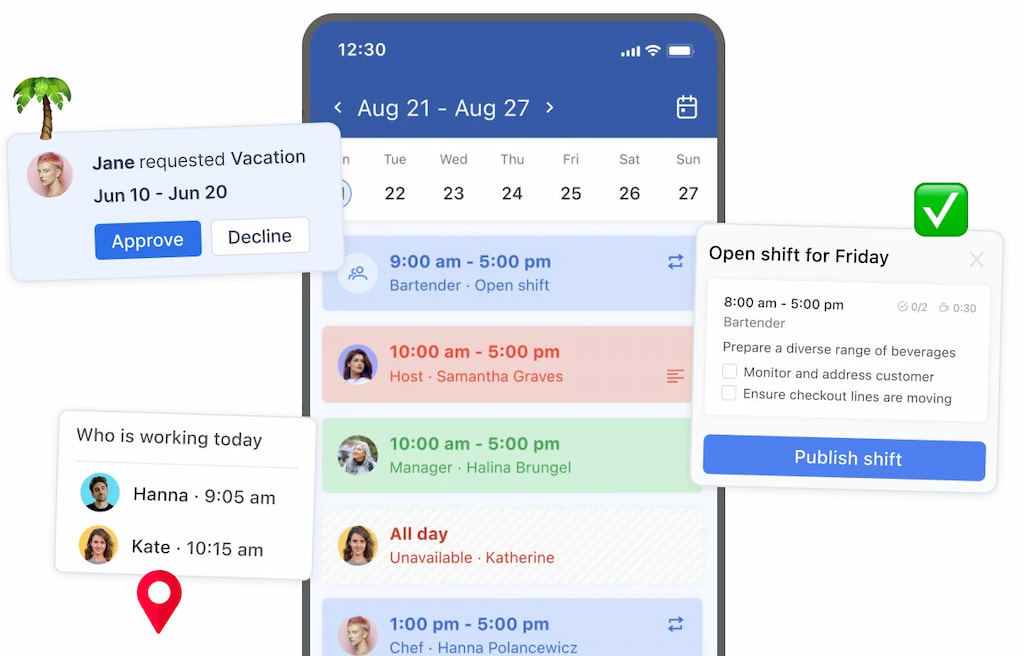
- 💬 Built-in chat: Share job details, safety tips, or urgent changes without extra apps.
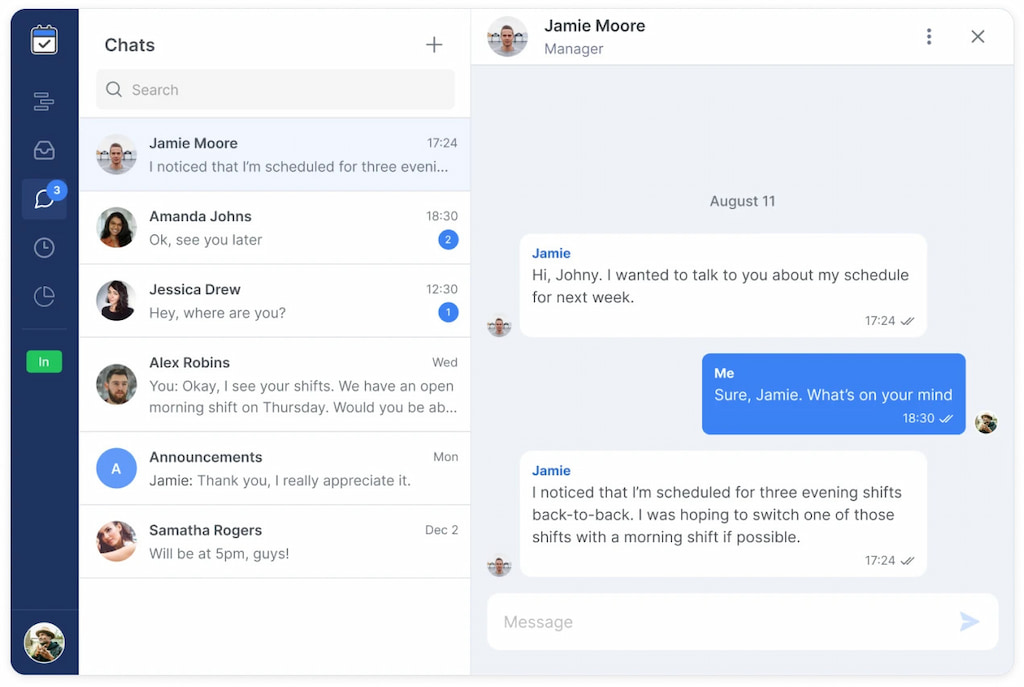
- 📋 Kiosk check-in: Tablet-based clock-in for crews starting at the shop.
- 💸 Free & paid plans: Core tools for free, upgrades for advanced needs.
Example:
A small crew posts weekly jobs—like EV charger installs or panel upgrades—as shifts in the app. Electricians accept or swap them. When a storm hits, an emergency shift is posted, claimed, and completed within hours. Time is logged for payroll, and invoicing happens in a separate accounting tool.
While Shifts doesn’t include advanced CRM or quoting, it’s a great fit for simple, reliable job scheduling and time tracking.
🛠️ How to Choose the Right Electrician Staff Scheduling Software
🔍 Assess your needs and pain points
- List the types of work you handle (residential, commercial, industrial, emergency calls) and the number of technicians.
- Identify scheduling challenges: double bookings, miscommunication, overtime, emergency dispatch.
- Decide whether you need a standalone scheduling tool or an all‑in‑one FSM platform.
✔️ Determine must‑have features
- Use the features list above as a checklist: dispatch management, mobile access, time tracking, customer management, service agreements, notifications, integration, analytics.
- Prioritize features based on your pain points.
📋 Research and shortlist platforms
- Use comparison guides like BuildOps and Apploye to identify platforms that match your needs.
- Consider your business size and budget. Smaller teams might lean toward FieldVibe or Tradify; larger contractors might explore BuildOps or ServiceTitan; mid-range operations could consider Service Fusion or Jobber.
- Include general scheduling tools like Shifts by Everhour if you want simple scheduling and time tracking without extra overhead.
🖥️ Request demos and test user experience
- Arrange demos or free trials for at least three platforms. Evaluate dispatch board usability, mobile app functionality, and reporting tools.
- Test the system with a small set of jobs and a handful of electricians. Ask your team for feedback on ease of use and clarity of information.
🔗 Check integration capabilities and support
- Ensure the software integrates with your existing accounting, CRM, estimating, or inventory tools. Apploye highlights integration as crucial for smooth workflows.
- Ask about onboarding, training, and customer support. BuildOps emphasizes the importance of customer service and market specialization.
💰 Evaluate pricing and ROI
- Compare pricing models (per user, per feature, flat rate). Consider hidden costs like setup, training, and support.
- Estimate time saved, reduced errors, improved invoicing, and better utilization — the ROI often justifies the investment.
🚀 Plan implementation and training
- Roll out software in phases if needed. Start with scheduling and dispatch, then add invoicing or CRM features.
- Provide training sessions for office staff and technicians. Emphasize benefits like reduced paperwork and clearer schedules.
❓ Frequently Asked Questions
What does electrician scheduling software cost?
Costs vary. Entry-level plans start around $20–$80 per user/month, while full-featured platforms can range $100–$300 per user. Additional fees may include onboarding, training, and premium features. Shifts by Everhour offers a free plan for small teams.
Do I need electrical contractor scheduling software if I have QuickBooks?
QuickBooks manages accounting and invoicing but not scheduling or dispatch. Scheduling software fills this gap and often integrates with accounting tools, letting you export job data for invoicing.
How does scheduling software help with safety and compliance?
Some tools track licenses, certifications, and permits, ensuring you assign only qualified techs to high-risk jobs by storing and monitoring compliance documents.
Can these tools handle both residential and commercial jobs?
Yes. Platforms like BuildOps and ServiceTitan support complex, multi-property projects, while others like FieldEdge focus more on residential or mixed service work. Choose based on your job types.
How do I know if my techs will adopt the software?
Pick an intuitive mobile app and involve techs in testing. Provide training and highlight benefits like fewer office calls and easy access to job details, photos, and signatures.
🚀 Conclusion: Powering Up Your Electrical Business with Smart Scheduling
Electricians keep homes safe and businesses running—but behind every job is a system that coordinates techs, dispatchers, and customers. Manual scheduling can’t keep pace with today’s demands. Scheduling software for electricians brings it all together: customer records, real-time dispatch, time and cost tracking, automated alerts, and integration with quoting and invoicing.
The right tool depends on your business size:
- Large contractors → all-in-one platforms like BuildOps or ServiceTitan
- Residential shops → options like FieldEdge or Service Fusion
- Small teams → mobile-friendly apps like FieldVibe or Tradify
For a budget-friendly, flexible option, Shifts by Everhour delivers fast shift assignment, mobile convenience, availability tracking, and built-in chat.
With the right software, you cut admin work, keep crews prepared, delight customers, and protect profits. Try Shifts—or another platform—and see how streamlined scheduling transforms your operations.
Streamline your team and boost efficiency with the best pest control scheduling software today!
